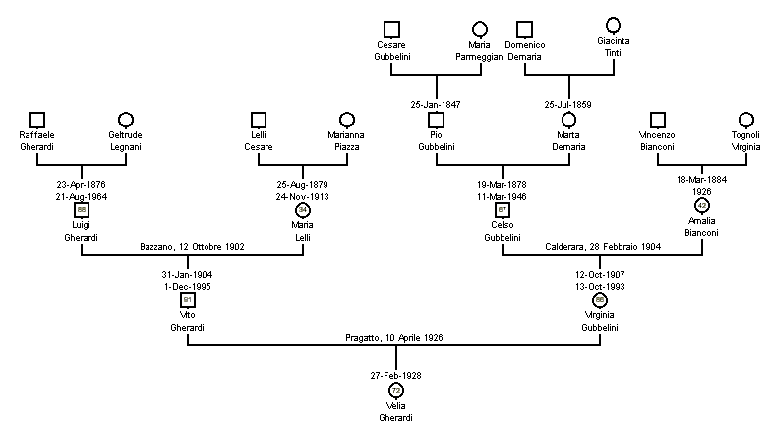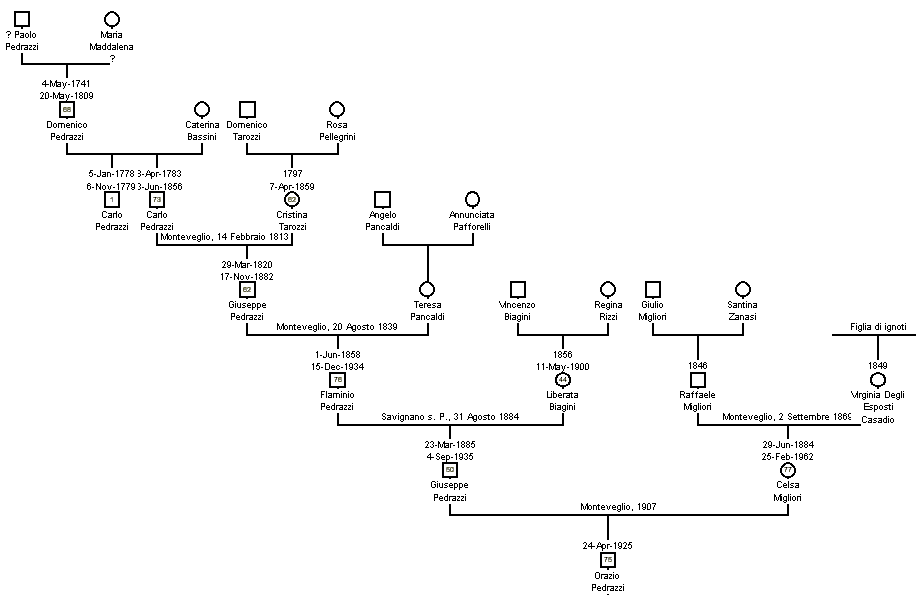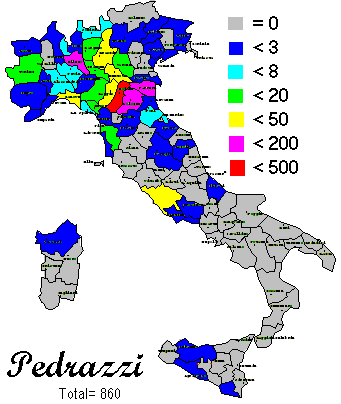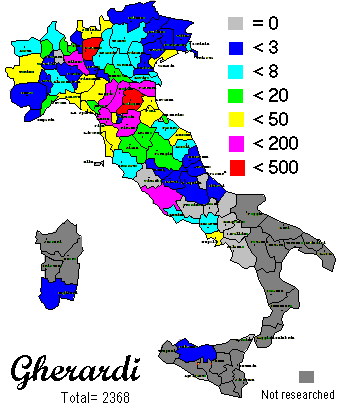The "Gherardi" line, up to my mother:
Actually, I never interested myself for genealogy until, middle 1998, only a few months after creating this web site, I received an e-mail from Mexico, from a young man who had my same surname (Pedrazzi), and was researching its origins, because, he said, this was a rare surname for that country. He had traced back his ancestors up to one of them that emigrated from Northern Italy around 1850, and was asking if I could help him going back from that point.
Of course Pedrazzi is a common name in Italy, and I supplied him this information, adding that in fact I had never thought about a similar research. Then, as months went by, I began to be curious for myself: and maybe there is a time, in life, when you feel the need to know your roots, where you come from, in order to be sure of where your are going... in the literal and symbolical meaning! Possibly I had reached this time. Fact is, this research excited me, and still does.
So I bought a book about genealogical research, and spent some free time going in town halls asking for birth, death and marriage certificates of my ancestors. In Italy this can be done by anyone, and is almost free of charge, the only drawback being that the so-called "Anagrafe" was created by law only with the beginning of Italy as a sovereign state of its own (Regno d'Italia), around 1860.
This means you collect in a few days about three-four generations back, and then you stop suddenly, and everything becomes more difficult and more fascinating... because the next typical source (at least in my present, limited, state of knowledge) are the parish churches. And the information is again available to the public, but is of course much more difficult to read and interpret. And a parish in the past could have been split, joined, and there can be may parishes in a single town. The records before 1820 begin to be written in Latin, with long standard phrases that really contain one or two points of useful information, sometime with an almost unreadable handwriting, or with ink that transpired on the opposite side of each page, or vanished almost completely, making them very often a real riddle. This kind of records are available for Italy back to 1600, theoretically 1566 (in the only parish where I did the research it is so!).
But, at the same time, reading those old yellowish books is the nearest thing to a time travel that you can experience in real life: after a short browsing, you become acquainted with the old priest that kept the books, you understand if he was tired or hurried, you begin to imagine the scene that is behind every phrase: scenes of happiness and of sorrow... the young couple marrying at a very early age, the small children dead at age one or two years (and how many of them!), the mother dying at thirty, her husband remarrying after a few years... you begin to know the friends families, because they appear as witnesses over and over at weddings, christenings and deaths....
Nevertheless, it is hard to trace your ancestors this way, and error-prone, too. At the moment I have limited myself to trying to trace my own surname, Pedrazzi, and my direct line of ancestors, also because of my present work location, that, since 1999, is near Stuttgart, in Germany, leaving me very limited time to do that research actively in Italy. But I plan to go on, as a long term project, at least to research also my mother surname, Gherardi.
The following images provide a simplified version of what I have done until now, stripped of all lateral lines (that are, at the moment, not part of my original intent, but that somehow come out as a by-product of the work). A textual version can be found here.
The "Pedrazzi" line, up to my father:

The "Gherardi" line, up to my mother:
The research that produced these data has been performed in the town halls until possible, and at the moment in only one (!) parish church, the S. Maria Assunta Church of Monteveglio, Bologna, Italy, the priest of which I must really thank for his kindness.
As it can be seen, I have been able, at the moment, to trace the surname Pedrazzi in Monteveglio back to 1741. Monteveglio is now a peaceful village in the west part of the province of Bologna, in the valley of the river Samoggia; over the centuries was the scene of many conflicts. It is well known for the abbey built by Matilde di Canossa. Some more information, unfortunately only in Italian, can be found here.
Not being able, at the present time, to do active research, I turned to other sources of information: as you may know, there is on the Internet a wealth of interesting sites, some of them offering really impressive search capabilities. One of those is certainly the "FamilySearch Internet Genealogy Service", maintained by The Church of Jesus Christ Of Latter-Day Saints. They give public access to everybody, independent from religion or nationality, and their database is continually growing.
A simple search for my surname showed me that the more ancient the records became, the more toward North they went. Ending with the most ancient of all in Switzerland! This gave me the idea that generated the two following images: I thought that a "surname" probably during centuries can "move" around, meaning that it will probably begin in a limited area, and then expand itself or even really displace the peak density in a new region, due to historical events, and of course other random effects. And I reasoned that it should leave a "trail" behind, in the form of a certain number of families with that surname in the area. Well, probably this is well known, but for me it was an original intuition. Using the on-line Italian telephone directory, and a lot of patience, I was able to produce the following two maps, for the two surnames Pedrazzi and Gherardi.


I think they speak for themselves! One should note that they represent absolute numbers of home telephone registered users in any province, and are not normalised with respect to the population of the province. Maybe I will do that one day or another. For example the 7 Pedrazzi in the province of Sondrio are much more significant than the 92 in the nearby Milano!
Observing the clear "trail" that the Pedrazzi surname seems to have left through the North of Italy, I was curious to check also with the Switzerland telephone directory: and, to my surprise, the total number of Pedrazzi there is more than 500, of which 300 only in the Canton Ticino! That, compared to the 860 in Italy, is even more impressive. Expressed as "per million" of the population, that is about 15 in Italy against 70 in Switzerland! I do not know what this proves, if it proves anything, but my impression is that the Pedrazzi surname "was born" in Switzerland and migrated southwards somewhere around 1600.
If someone is doing similar research, or has interesting information to share, please feel free to write me! This is even one of the main purposes of this page!
I wish to personally thank here Daniel Morin for creating a program
like GenoPro, that originally I downloaded
from the network in one of the earlier versions, and that I find really
simple and useful for producing family trees. The two images in this page
are screen shots of the program, but it can do much, much more! Try
it! It is freeware.